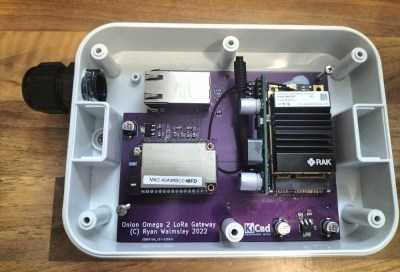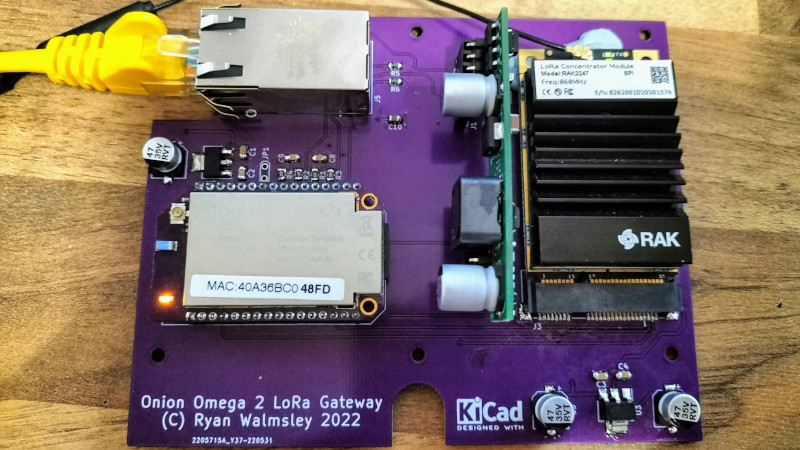It’s fair to say that right now is probably the worst possible time you could choose to design a new piece of hardware. Of course the reality is that, even in the middle of a parts shortage that’s driving the cost of many components through the roof (if you can even find them), we can’t just stop building new devices. In practice, that means you’ll need to be a bit more flexible when embarking on a new design — it’s like the Stones said: “You can’t always get what you want / But if you try sometime you’ll find / You get what you need”
For [Ryan Walmsley], that meant basing his new outdoor LoRa gateway on the ubiquitous Raspberry Pi was a non-starter. So what could he use in its place? The software situation for the Nano Pi Duo looked pretty poor, and while the Onion Omega 2+ was initially compelling, a bug in the hardware SPI seemed to take it out of the running. But after more research, he found there was a software implementation that would fit the bill.
 With his Pi alternative in hand, now he had to find the rest of his components. Since the design wasn’t something that would necessarily go into production, [Ryan] reasoned he could get away with using off-the-shelf modules from the likes of Adafruit and The Pi Hut rather than implementing their functionality on his PCB. It would be a bit more expensive, but meant less work for him. With the big features like Power over Ethernet handled, he just needed to tie it all together with some 0805 passives for easy hand assembly.
With his Pi alternative in hand, now he had to find the rest of his components. Since the design wasn’t something that would necessarily go into production, [Ryan] reasoned he could get away with using off-the-shelf modules from the likes of Adafruit and The Pi Hut rather than implementing their functionality on his PCB. It would be a bit more expensive, but meant less work for him. With the big features like Power over Ethernet handled, he just needed to tie it all together with some 0805 passives for easy hand assembly.
Testing and assembly went better than it did for his previous LoRa gateway, and the resulting board fits snugly into a commercial weatherproof enclosure. [Ryan] says each one costs between $300 and $350 USD to put together, but it sounds like he hasn’t decided what the fate of this particular design is yet. Perhaps your comments below will help him chose whether he tries to sell them as kits or release the files and turn this into an open hardware project, so don’t be shy.
Thanks to [Neilios] for the tip.
















While I commend the effort, I really see no point. It’s a PCB with a handful of voltage regulators and a bit of wiring for three modules, one of which has known hardware problems. You can buy two commercially available gateways for the price of this thing.
Two commercially available gateways for this price? Do you have a link please?
I couldn’t find anything close that was external, poe and supported basics station?
Mikrotik LR8 (or LR9 if you’re in the US). Doesn’t support basics station (yet), doesn’t support proper PoE, the built-in antenna isn’t the best, but it’s outdoor-ready (i.e. you can put it on a pole in the rain when oriented properly, but it’s not going to withstand being submerged or sprayed from below) and has reasonably good performance and gets regular security updates. So if you absolutely need proper PoE and absolutely need basics station, this won’t do, but otherwise, it’ll work just fine. Of course, prices and availability vary depending on where you’re from.
Outdoors ones, less so. I guess I could have got one with an indoor case and converted that. Part of the reason behind the project was also to learn Kicad as I’m used to Eagle. So wanted something simple to do.
Price wise it seems reasonable in comparison to other outdoor solutions though.
I commend you for getting into Kicad. I made the switch from Eagle a decade ago, but I was a beginner then and didn’t have too much to “un-learn.” I’ve been very happy with the trajectory of Kicad’s development, each new release is a big jump in capability
@Tom Nardi said: “[Ryan] says each one costs between $300 and $350 USD to put together…”[1]
Why so expensive? Unfortunately [Ryan]’s write-up does not contain a schematic or BOM. But I think I can source and price the main pieces: Qty.-1 Onion Omega2+ SOM $25.31 [2] + Qty.-1 RAK2247 LoRaWAN Concentrator module ~115.00 USD w/antenna = ~$140.00 USD [3]. The rest of the parts surely cannot add an additional $160 – $210 USD. Or am I missing some expensive hardware? And/or is there a software license and/or maintenance fee for the RAK2247 Concentrator?
One thing to note, I looked at the Onion Omega2/2+ specs and community forum, you’re pretty-much limited to running OpenWRT Linux out of the box. That’s understandable given the SOM comes with only 16/32MB flash and 64/128MB DDR2 DRAM. I recommend using the Onion Omega2+, it has the larger flash and DRAM, and it comes with an SD card slot.
* References:
1. Designing a New Outdoor LoRa Gateway, Ryan Walmsley, Jun 28, 2022
https://ryanteck.uk/building-a-new-outdoor-lora-gateway/
2. Onion Omega2+ (OM-O2P), MT7688AN/MIPS24KEc @ 580MHz, RAM: 128MB, Flash: 32MB, Packaging: Through-Hole, SD-Card: Yes, Qty.-1 $25.31, 2,094 in stock.[1]
https://www.mouser.com/ProductDetail/Onion/OM-O2P?qs=sGAEpiMZZMu3sxpa5v1qrvoXwgKUd5RfIHwZxSdKs3I%3D
3. RAK2247 Concentrator for LoRaWAN US 915 MHz w/antenna % SPI Qty.-1 ~$115.00 USD in stock.[2]
https://store.rakwireless.com/products/rak2247-lpwan-gateway-concentrator-module?variant=39942874005702
At the time of writing I did a rough ballpark figure of £250-300. As there was a few comments I did a bit more maths to get a more accurate figure which is roughly £160-200, or $200-250.
As for the onion indeed I used the plus variant, while you are limited to OpenWRT for what I wanted (just a basic linux SBC that can run initially the Lora Packet Forwarder and soon the Basics Station) it does the job.
Rough BOM is:
Main PCB Inc Shipping, + Components = £8
Onion Omega 2+ = £25
LoRa Module (There’s both the RAK and also the SEEED one should work) = £100ish
IP Rated Outdoor Case = £20
POE Module = £8.60
About £160 in total, having a bit of buffer there is good as the prices are fluctating at the moment too. £200ish gives some budget for a good antenna too.
So are you you using one or two concentrator modules (see my question below)?
Does it cost so much because it needs two (2) RAK LoRaWAN concentrators instead of one? If I study the photo, I can see two PCIe edge connectors peeping out, so that means two concentrators right? Maybe two are required to increase the number of channels?
Raspberry Pi Compute Modules (CM4) 4GB RAM going for £125 in UK. Bargain!!
No one mentioning Helium the biggest lorawan network?
Nobody is mentioning helium because it’s just yet another crypto scam.
Sure, but the hardware’s generic; buy an outdoor box on eBay and reprogram the raspberry pi, lora radio and POE to do whatever you want.
“$300 and $350 USD to put together”
Thank you Semtech patents for the monopoly pricing:
https://lorawan.es/en.html
“LoRa is patented and acquired by Semtech, which also has developed this wireless data communication technology”
Those multi-channel gateways are far too expensive for what they do.